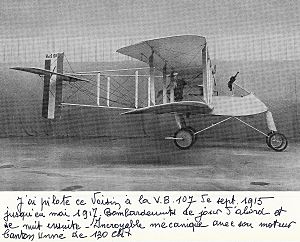Voisin 5
| Voisin 5 | |
|---|---|

| |
| Role | Bomber/Reconnaissance |
| Manufacturer | Voisin |
| Introduction | early 1915 |
| Primary users | |
| Number built | 350[1] to ~400 (France)[2] to >450[3][note 1] |
| Variants | Anatra "Ivanov Voisin", Voisin 6 |
| Wingspan | 14.7 m (48 ft 4 in) [5][6][3] |
| Engine | 140-150hp Salmson P9 radial |
| Armament | front flexible MG or front flexible 37mm cannon 50 kg (110 lb)[5]-240 kg (521 lb)[3] of bombs |
| Crew | 2 |
| Max Speed | 103 km/h (64 mph)[3] to 105 km/h (65 mph)[7][6] to 109 km/h (68 mph)[8] |
| Climb | 1,000 m (3,280 ft) in 10:00[5] 2,000 m (6,560 ft) in 22:00[8]-23:00[5][3] 3,000 m (9,800 ft) in 45:00[5] |
| Ceiling | 3,500 m (11,500 ft) [7][6] |
| Endurance | 3:30[7][5][6] to 4:00[8][3] |
While the Voisin 3 had proved a successful design, it could not easily mount the new 150hp Salmson P9 radial engine. The Voisin 5 was created in response, with a more streamlined central nacelle, wider-chord wings, and a stronger undercarriage. Its factory designation was the "LAS" ("LBS" with the cannon). Roughly 400 were built, and they were used by many escadrilles starting in early 1915. It served widely until the type was gradually replaced with Farman F.40's, Sopwith Strutters, and Breguet 14's from mid 1916 to late 1916. In Serbia, French units continued to use the Voisin 5 through the middle of 1917.[2]
Some Voisin 5 and 6 aircraft were modified for ground attack and carried a 37mm Hotchkiss cannon instead of a machine gun.
A single Voisin 5 was analyzed and improved in Russia and Anatra began building the "Ivanov Voisin".
For more information, see Wikipedia:Voisin V.
Timeline [note 2] [note 3]

Game Data
Wings of Glory
| Version | Availability | Maneuver | Damage | Dmg Points | Max Alt. | Climb |
|---|---|---|---|---|---|---|
| LAS with MG | Jan15-Nov16 | XC | B/- | 10 | 9 | 7 |
| LBS with cannon | XC | C/- | 10 | 9 | 7 |
Card Links
Miniatures and Models
1:144 Scale
- Shapeways:
- Standard: Reduced Aircraft Factory
- Cannon-armed: Reduced Aircraft Factory
1:285/6mm/1:288 Scale
- Shapeways:
- Standard: Reduced Aircraft Factory
- Cannon-armed: Reduced Aircraft Factory
- Metal Cast: Goblintooth/H.A./MSD FRG-04
1:300 Scale
- Metal: Heroics & Ros GWA222
Resources
Isometric Top Views
-
Standard model
-
Cannon-armed model
References
- Notes
- Citations
- Bibliography
- Enzo Angelucci, ed. The Rand McNally Encyclopedia of Military Aircraft, 1914-1980. New York: The Military Press, 1983 edition. ISBN 0-517-41021-4.
- Dr. James J. Davilla and Arthur M. Soltan. French Aircraft of the First World War. Flying Machines Press, 1997. ISBN 0-9637110-4-0.
- Vital Ferry. French Aviation During the First World War. Paris: Histoire and Collections, 2014. ISBN 978-2-35250-370-5
- W.M. Lamberton and E.F. Cheesman, Reconnaissance & Bomber Aircraft of the 1914-1918 War. Great Britain: Harleyford Publications Ltd., 1962. ISBN 9780900435027
- Kenneth Munson, Bombers: Patrol and Reconnaissance Aircraft, 1914-1919. New York: The MacMillan Company, 1968, Blandford Press Ltd. ISBN 978-0753721711
- Ian Philpott, The Birth of the Royal Air Force. Great Britain: Pen & Sword Books Limited, 2013. ISBN 978-1-78159-333-2

